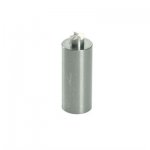I find that I can shoot the difference between a thousandth of an inch variance in primer seating depth. When I don't clean the pockets, I'll see a depth ES of about 0.003 or more. When I clean them, that will drop to 1.5-2 thousandths. When I uniform them, I can keep ES under a thousandth, and SD's will run down into the 3-6 ten thousandths area... which becomes difficult to even measure reliably.
Over the years, I've demonstrated that primer seating depth is very closely tied to ignition reliability. Not just in the "does it go bang" category, but the finer more nuanced side of ignition which can have a monumental affect on accuracy. If you have a finely tuned ignition system in your rifle, you can certainly see the effects of primer seating depth with a minimum of testing. If your ignition system is not tuned, then primer seating depth may not make a singular bit of difference. So it's important to understand the goals of the shooter before saying its something that should be done. If you're running quality equipment and a quality rifle, you can avoid doing most things on the loading bench, and still be able to hold half MOA precision or close to it. That'll produce a typical real world accuracy of sub-MOA. If you want to be able to hit a half inch dot at 100yds every time you press the trigger, you'll need to do quite a lot of things. Taking care of primer pockets and being able to consistently position primers is certainly one of those things.
This whole conversation relies on an understanding that OK performance is relatively easy to get these days. Most shooters are quite happy there. It requires very little effort and time. However, the more you try to push into shooting small... the more problems you discover with your process which require solutions. We have many of those solutions these days with all the new equipment becoming available. The smaller you try to shoot, the more the entire ecosystem matters. Over time, you'll discover which operations and equipment stations are holding you back. Solving the problem at each station carries with it a financial commitment and a time commitment. Usually if you pay more, you can buy time. You can also buy ease of use and an improved overall experience.
Yet regardless of what you decide, every operation demands uniformity. You don't get to decide to have maximum accuracy and precision, and simultaneously get to decide to leave out various uniform operations. Each little op might not mean much individually, but in the aggregate... can add up to be very substantial. That right there is how you get from being a consistent half MOA shooter, to being a consistent quarter MOA shooter. Its the aggregate, when the sum total of all effort an expense is added. You find where the process or equipment is weak, and you press your will against it until it isn't anymore. Through the cooperation of the precision rifle community, mostly it is just not that difficult anymore. We have great tools to cover most ops.
I would submit that to answer this main question of the thread, you must know who you are as a shooter and what your goals are. You might be performing well enough to not care about most things. However, life starts getting complicated and often expensive when you try to improve your performance or at least your experience when doing various tasks. The part about shooting I enjoy most, is the availability of improvement. There is always something for me to chase and always some delta I've not yet reached. The pursuit keeps me challenged and fulfilled.
I don't obsess about every rifle I own. Though there are a few that get the full treatment. No stone is left unturned.


